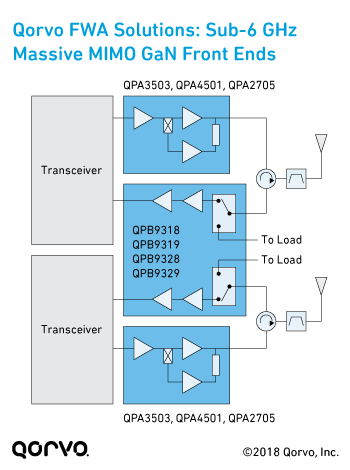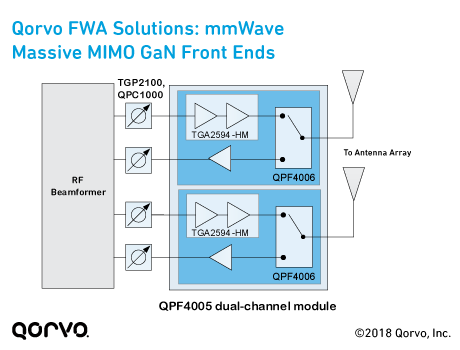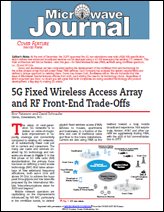5 Things to Consider When Designing Fixed Wireless Access (FWA) Systems
April 13, 2018
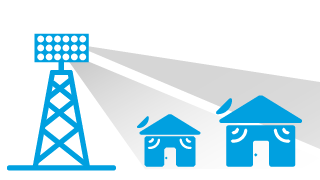 One
of the earliest uses of 5G will be
fixed wireless
access (FWA), which promises to deliver gigabit internet speeds. FWA
can be delivered to homes, apartments and businesses in a fraction of the time
and cost of traditional cable/fiber installations. As with any technological
advance, FWA brings new design hurdles and technology decisions. Let’s
dig into five things to consider when designing FWA systems:
One
of the earliest uses of 5G will be
fixed wireless
access (FWA), which promises to deliver gigabit internet speeds. FWA
can be delivered to homes, apartments and businesses in a fraction of the time
and cost of traditional cable/fiber installations. As with any technological
advance, FWA brings new design hurdles and technology decisions. Let’s
dig into five things to consider when designing FWA systems:
- The choice of frequency spectrum: millimeter wave (mmWave) or sub-6 GHz
- Achieving higher data rates with antenna arrays
- All-digital or hybrid beamforming
- Power amplifier (PA) technology choices: silicon germanium (SiGe) or gallium nitride (GaN)
- Choosing components from today’s RF front-end (RFFE) product portfolios
#1: Spectrum choice: mmWave or sub-6 GHz
The first decision is whether to use mmWave or sub-6 GHz frequencies for FWA:
- mmWave. These higher frequencies offer a large amount of contiguous spectrum available at low cost. mmWave supports component carriers up to 400 MHz wide and enables gigabit data rates. The challenge is path loss due to obstacles like vegetation, buildings and interference. However, don’t assume FWA is useful only in clear line-of-sight settings between the base station and the home — FWA can actually perform very well in both urban and suburban settings. It’s true that vegetation and interference are challenging, but these can be overcome with antenna arrays that provide high gain.
- Sub-6 GHz. This lower-frequency spectrum helps overcome the problems caused by obstructions, but at a cost. Only 100 MHz of contiguous spectrum is available, so data rates are lower.
Efficient use of frequency range (sub-6 GHz or mmWave) is critical to
scaling deployments. The choice for any situation will depend on balancing the
goals of speed and coverage.
#2: Achieving higher data rates with antenna arrays
An FWA system will also need to employ active antenna systems (AAS) and massive MIMO (multiple input/multiple output) to deliver gigabit service.
- AAS provides many directional antenna beams. These beams are redirected in less than a microsecond, enabling beamforming that offsets the greater path loss associated with high frequencies.
- Massive MIMO uses arrays of dozens, hundreds or even thousands of antennas, allowing simultaneous transmission of single or many data streams to each user. The results are improved capacity, reliability, high data rates and low latency. Beamforming also enables less inter-cell interference and better signal coverage.
Learn more about AAS and massive MIMO: How Carrier
Networks Will Enable 5G
#3: All-digital or hybrid beamforming
A third element to consider is the type of beamforming to employ — all-digital or hybrid.
All-digital approach
The most obvious choice in mmWave base station applications is to upgrade the current platform. You could explore extending all-digital beamforming massive MIMO platforms used for sub-6 GHz frequencies, but this isn’t a plug-and-play solution.
An all-digital approach faces these design constraints:
- Power consumption. Digital beamforming uses many low-resolution analog-to-digital converters (ADC). But ADCs with a high sampling frequency and a standard number of effective bits of resolution can consume a large amount of power. This power consumption can become the bottleneck of the receiver. A large AAS with massive bandwidth presents a huge challenge for an all-digital beamforming solution. Essentially, the power consumption will limit the design.
- The need for two-dimensional scanning in dense urban environments. The required scanning range depends on the deployment scenario, as shown in the figure below. In a dense urban landscape, wide scan ranges are needed in both azimuth (~120°) and elevation (~90°). For suburban deployments, a fixed or limited scan range (< 20°) in the elevation plane may be enough. A suburban deployment requires limited scan range or half as many active channels to achieve the same effective isotropic radiated power (EIRP), which reduces power and cost.
Remember: An array’s size is dependent on:
- The scanning range (azimuth and elevation)
- Desired EIRP
EIRP is the product of:
- The number of active channels
- Conducted transmit power of each channel
- Beamforming gain (array factor)
- Intrinsic antenna element gain

To achieve the target EIRP of 75 dBm and beamforming gain, an all-digital solution using today’s technology would need 16 transceivers. This would equal a total power consumption of 440 W. But for outdoor passive-cooled, tower-top electronics, it’s challenging to thermally manage more than 300 W from the RF subsystem. We need new technological solutions.
Efficient GaN Doherty PAs with digital predistortion (DPD) may provide the required margin, but these devices are still in development for mmWave applications. But it won’t be long before we see an all-digital beamforming solution. Several developments will make it a reality:
- Next-generation digital-to-analog and analog-to-digital converters that save power
- Advances in mmWave CMOS transceivers
- Increased levels of small-signal integration
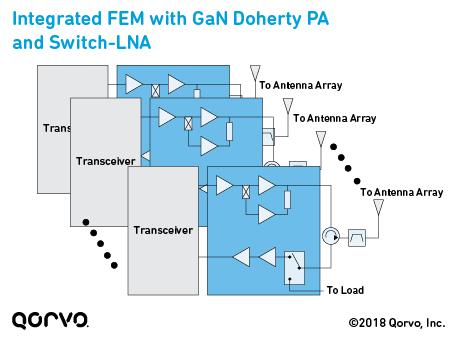
Hybrid approach
An alternative is hybrid beamforming, where the precoding and combining are done in both baseband and RF front-end module (FEM) areas. By reducing the total number of RF chains and analog-to-digital and digital-to-analog converters, hybrid beamforming achieves similar performance to digital beamforming while saving power and reducing complexity.
Another advantage of the hybrid approach is the ability to meet both a suburban fixed or limited scan range (<20º) and dense urban deployments with wide scan ranges in both azimuth (~120°) and elevation (~90°).
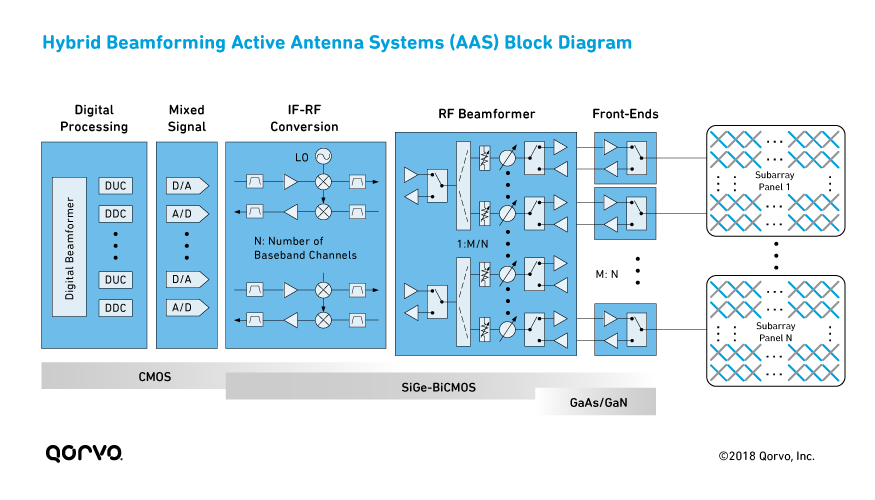
The bottom line: all-digital and hybrid approaches both have advantages and
disadvantages. We believe the hybrid approach is more appealing and doable
today, but new products on the horizon could make the all-digital approach
equally appealing in the future.
#4: PA technology choices: SiGe or GaN
The technology you choose for the FWA front end depends on the EIRP, antenna gain and noise figure (NF) needs of the system. All are functions of beamforming gain, which is a function of the array size. Today, you can choose between a SiGe or GaN front end to achieve your desired system needs.
In the U.S., the Federal Communications Commission (FCC) has set high EIRP limits for 28 GHz and 39 GHz spectrum, as shown in the following table.
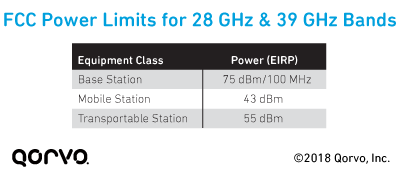
To achieve 75 dBm EIRP with a uniform rectangular array, the PA power output required per channel reduces as the number of elements increases (i.e., the beamforming gain increases). As shown in the below figure, as the array size gets very large (>512 active elements), the output power per element becomes small enough to use a SiGe PA, which could then be integrated into the core beamformer RFIC.
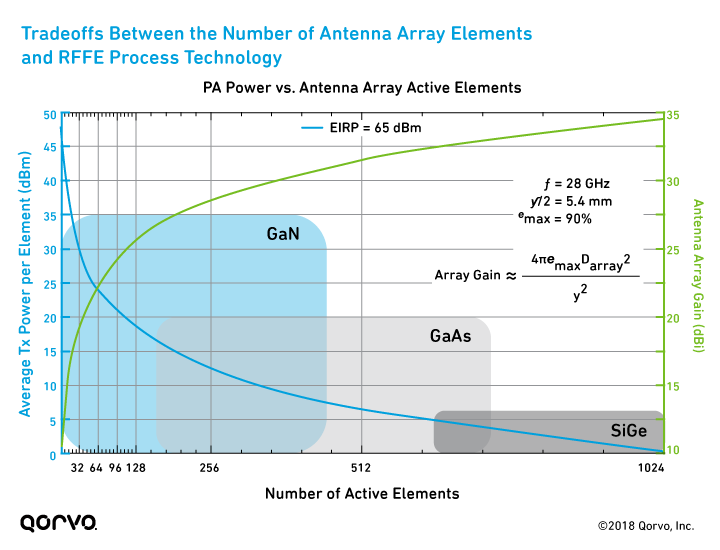
As you can see from the table below, a SiGe PA can achieve 65 dBm EIRP using 1024 active channels. However, by using GaN technology for the front end, the same EIRP can be achieved with 16x fewer channels.
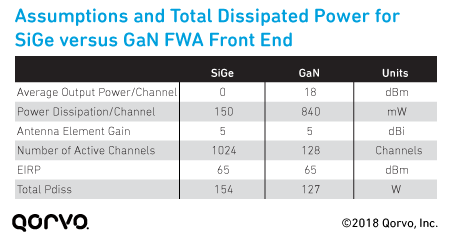
A GaN FWA front end provides other benefits:
- Lower total power dissipation. To ensure an accurate comparison, the GaN power dissipation includes an extra 19.2 watts, to account for the 128 beamformer branches needed to feed the front ends. As shown in the following figure, at the target EIRP of 65 dBm, GaN provides a lower total power dissipation (127 Pdiss) than SiGe. This is better for tower-mounted system designs.
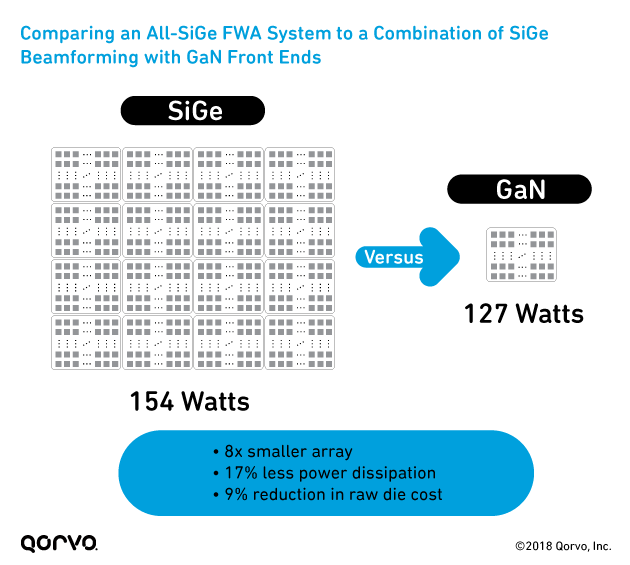
- Better reliability. GaN is more reliable than SiGe, with >107 hours MTTF at 200°C junction temperature. SiGe’s junction temperature limit is around 130°C.
- Reduced size and complexity. GaN’s high power capabilities reduces array elements and size, which simplifies assembly and reduces overall system size.
The takeaway: In wireless infrastructure applications, reliability is
imperative because equipment must last for at least 10 years. For FWA,
GaN is a better choice than SiGe for reliability, cost, lower power
dissipation and array size.
#5: Choosing from today’s RF technology
The last consideration is selecting product solutions that are being used in real-world applications. Several RF companies are positioned to support the development of sub-6 GHz and cmWave/mmWave FWA infrastructure. Qorvo, for instance, is already supplying products for many Tier 1 and Tier 2 supplier field trials. Across the RF industry, examples of products for FWA include:
- Sub-6 GHz products: Dual-channel switch/LNA modules and integrated Doherty PA modules
- cmWave/mmWave: Integrated transmit and receive modules
Additionally, in the 5G infrastructure space, several things are a must:
- Integration
- Meeting passive cooling requirements at high temperatures
To support these trends, Qorvo has created integrated transmit and receive
modules for cmWave/mmWave, as well as integrated GaN FEMs. These integrated
modules include a PA, switch and LNA, and have high gain to drive the core
beamformer RFICs. To meet the infrastructure passive-cooling specification, we
use GaN-on-SiC to support the higher junction temperature.
For more information on Qorvo solutions for FWA, click on the images below or visit our 5G Infrastructure page, where you'll find product details and interactive block diagrams.
Learn more about these products:
FWA is approaching — fast
FWA implementation has begun, and full commercialization is approaching rapidly. Today, we believe hybrid beamforming is the best approach. Additionally, GaN, along with SiGe core beamforming, meets FCC EIRP targets of 75 dBm / 100 MHz base station targets. This approach also minimizes cost, complexity, size and power dissipation.
For more information on application-specific components, visit
Qorvo’s 5G Infrastructure
solutions online. For technical guidance and applications support, please
visit our Technical
Support information.
Learn More about FWA
Read recent articles from Qorvo experts:
Have another topic that you would like Qorvo experts to cover? Email your suggestions to the Qorvo Blog team and it could be featured in an upcoming post. Please include your contact information in the body of the email.
